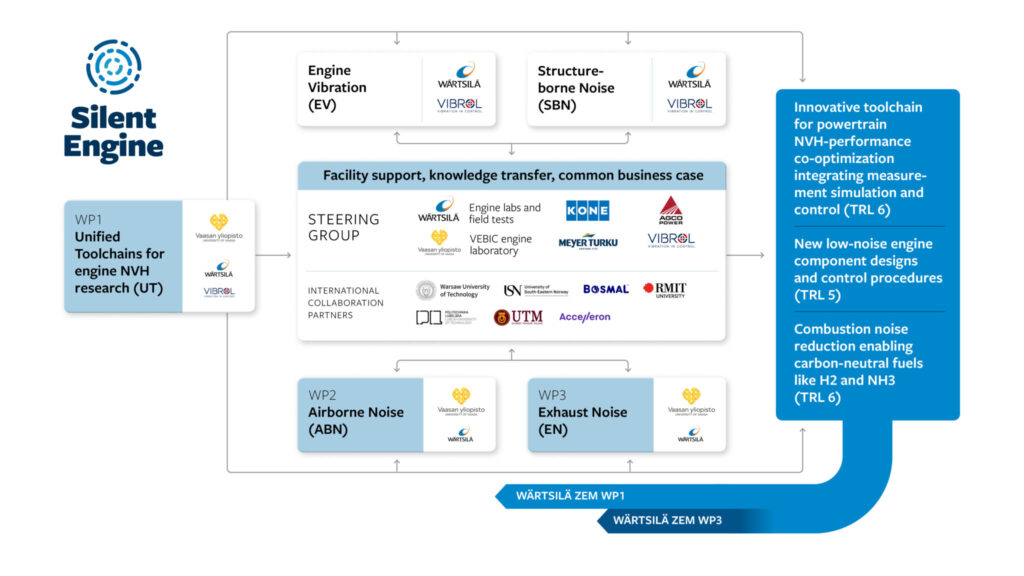
The Silent Engine project aims to develop silent and vibration-free innovations by fast-tracking, that is parallel development instead of slow, incremental improvement.
With novel combustion technologies, noise is more of a constraint in reaching zero emissions than the exhaust components. The project aims to remove this roadblock for future powertrains but also emphasise new quality in coordinated noise, vibration, and performance research. This methodological development is important so that in the future, the control complexity can be handled better and even more superior propulsion systems can be created.
The Silent Engine project is directly linked to the Business Finland Veturi ecosystem “Zero Emission Marine” (ZEM) programme initiated by Wärtsilä (2022–2025). Silent Engine contributes in several ways. For instance, Silent Engine secures real-world emission (including noise) compliance for technologies that enable the introduction of green fuels – one of the main focuses of the university’s research platform VEBIC.
As the primary research actor in Silent Engine, the University of Vaasa will handle two key phenomena that cause engine noise – the so-called airborne noise and exhaust noise. Vibration excitations and related structure-borne noise will be handled by Wärtsilä and Vibrol in connected company projects.
The Silent Engine project creates high-level expertise in noise and vibration management for the industry to meet the tightening noise emission requirements. In Finland, there is a lack of competence and resources when it comes to noise and vibration. It is expected that the results of this project will have a significant impact on the development of industrial competitiveness. The project will promote the transition to carbon-neutral fuels in the industry.
Silent Engine is an individual research project (of “Research networked with economic life”). The three-year project started on October 1st, 2022. Out of the total project volume of 1.33 M€, 70% comes as support from Business Finland. The companies involved in the project and the University of Vaasa fund the rest.
The Silent Engine project consists of the following Work Packages:
WP1 Unified Tool-chains for engine NVH research. Read more
WP2 Airborne Noise. Read more
WP3 Exhaust Noise. Read more
The measurable objectives are:
- Create a set of consolidated methods for modern engine acoustics, by integrating state of the art measurement and simulation solutions in co-optimization with performance parameters.
- For the state of the art marine/power plant combustion engines, by improved subsystem design and new control functions, create a pathway for -5dB noise reduction without trade-off on efficiency and emissions.
- For novel combustion concepts, and new fuels (including hydrogen and ammonia) explore efficiency (50% target) and emission (EU-Stage V target) improvement potential while keeping the 110 dB noise emission limit as a constraint
Key deliverables:
- State-of-the-art measurement setup for combustion/exhaust component noise separation and methods
- New set of sub-models for turbine noise, piston slap, injection, and combustion-borne noise implementable in industry-grade 1D-performance simulation
- Closed loop H2/RCCI combustion noise controller compatible with RCCI combustion performance control and associated virtual sensors
- New low-noise air path design for next-generation multi-fuel engines